Analysis of Enron's Ethics and Governance: ACCT20080 Report
VerifiedAdded on 2022/08/27
|16
|3786
|34
Report
AI Summary
This report provides a detailed analysis of the Enron case, examining its corporate governance structure and ethical failures. It applies ethical theories such as deontology and egoism to understand the unethical behaviors of Enron's leaders. The report evaluates the ethical decision-making processes within Enron using the AAA model and the Ferrell, Fraedrich, and Ferrell model. The analysis covers the application of these models and theories to identify the factors that contributed to the company's collapse, emphasizing the importance of ethical leadership and responsible decision-making in corporate environments. The report also includes an executive summary, introduction, conclusion and a reference list.
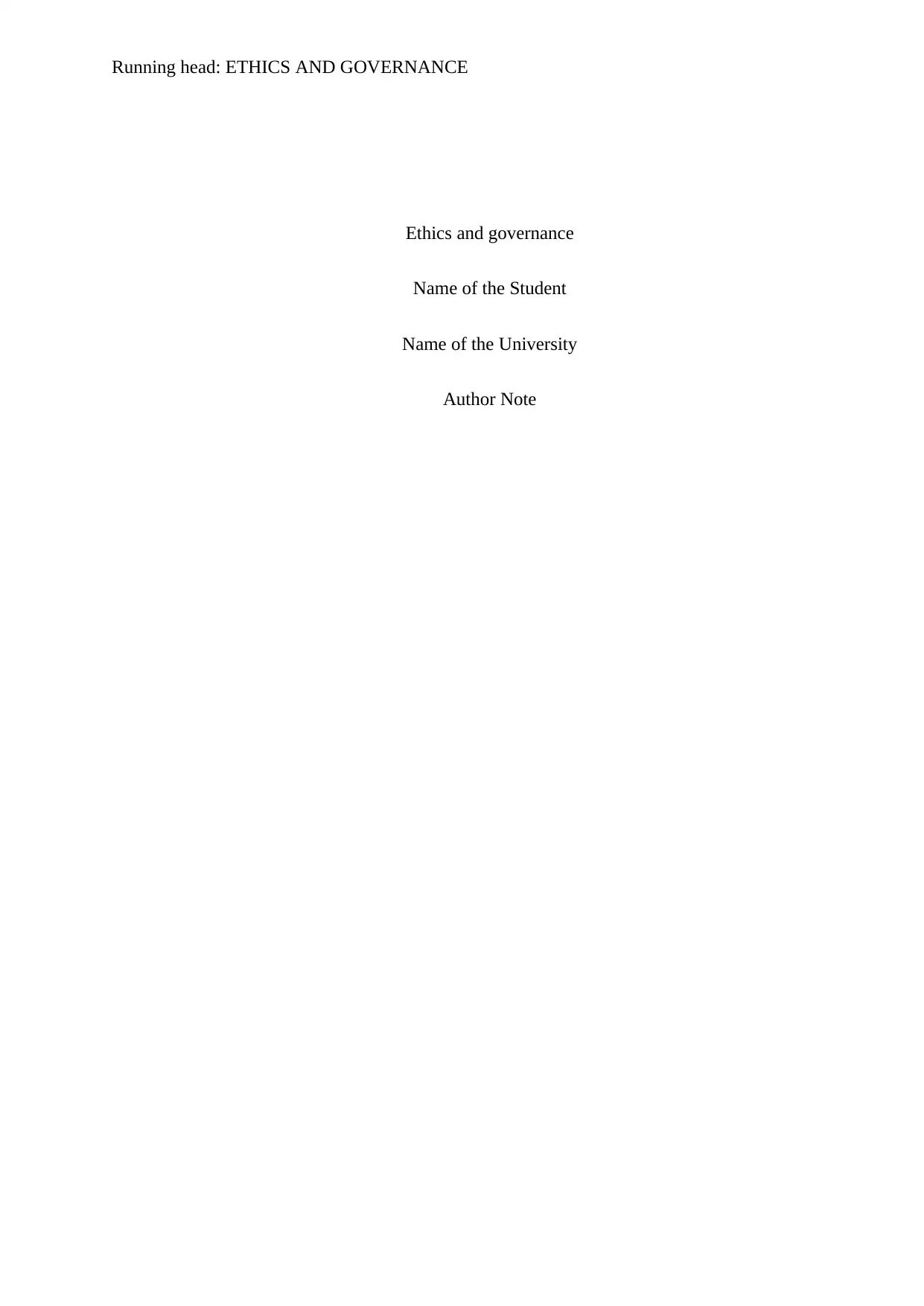
Running head: ETHICS AND GOVERNANCE
Ethics and governance
Name of the Student
Name of the University
Author Note
Ethics and governance
Name of the Student
Name of the University
Author Note
Paraphrase This Document
Need a fresh take? Get an instant paraphrase of this document with our AI Paraphraser
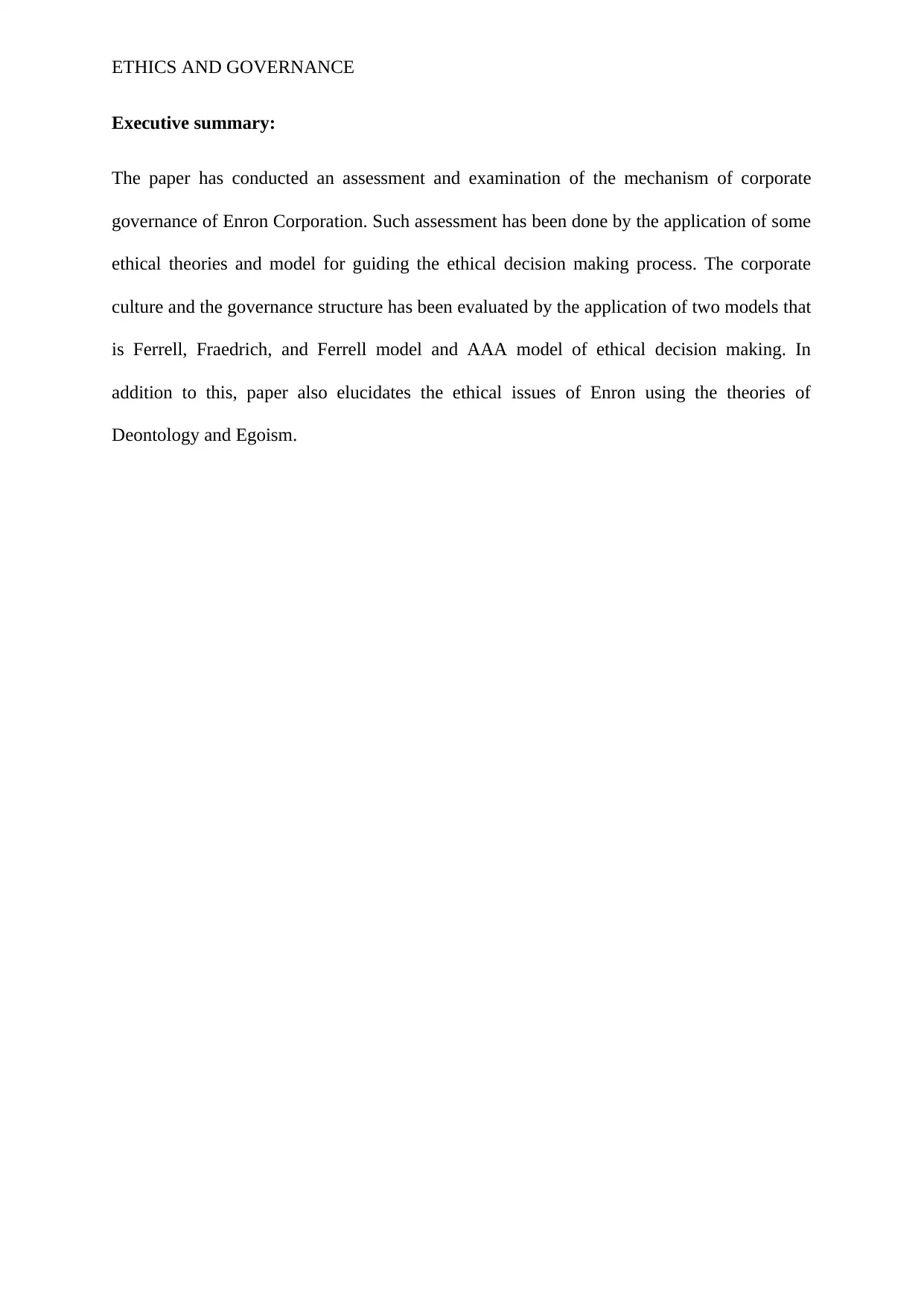
ETHICS AND GOVERNANCE
Executive summary:
The paper has conducted an assessment and examination of the mechanism of corporate
governance of Enron Corporation. Such assessment has been done by the application of some
ethical theories and model for guiding the ethical decision making process. The corporate
culture and the governance structure has been evaluated by the application of two models that
is Ferrell, Fraedrich, and Ferrell model and AAA model of ethical decision making. In
addition to this, paper also elucidates the ethical issues of Enron using the theories of
Deontology and Egoism.
Executive summary:
The paper has conducted an assessment and examination of the mechanism of corporate
governance of Enron Corporation. Such assessment has been done by the application of some
ethical theories and model for guiding the ethical decision making process. The corporate
culture and the governance structure has been evaluated by the application of two models that
is Ferrell, Fraedrich, and Ferrell model and AAA model of ethical decision making. In
addition to this, paper also elucidates the ethical issues of Enron using the theories of
Deontology and Egoism.
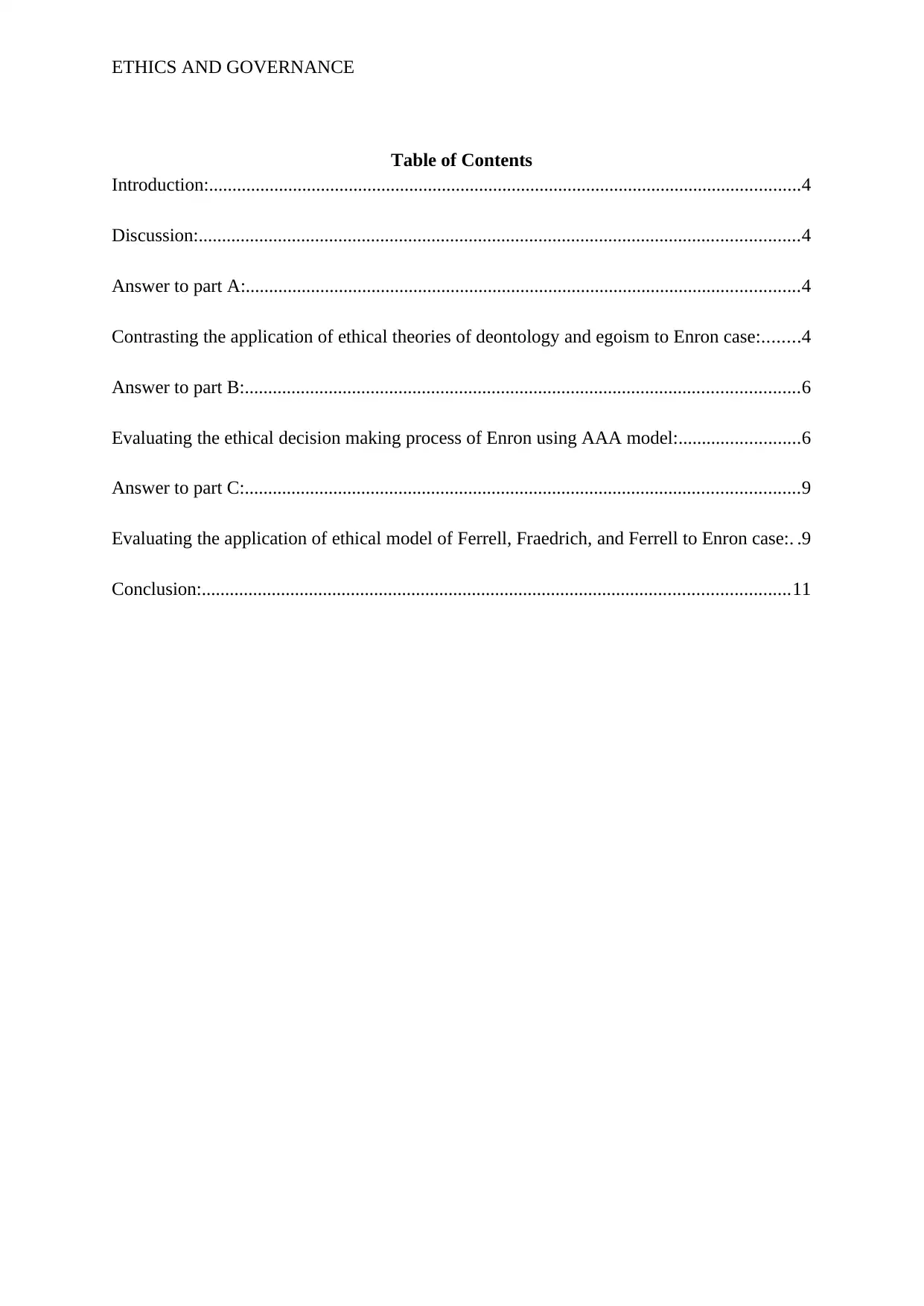
ETHICS AND GOVERNANCE
Table of Contents
Introduction:...............................................................................................................................4
Discussion:.................................................................................................................................4
Answer to part A:.......................................................................................................................4
Contrasting the application of ethical theories of deontology and egoism to Enron case:........4
Answer to part B:.......................................................................................................................6
Evaluating the ethical decision making process of Enron using AAA model:..........................6
Answer to part C:.......................................................................................................................9
Evaluating the application of ethical model of Ferrell, Fraedrich, and Ferrell to Enron case:. .9
Conclusion:..............................................................................................................................11
Table of Contents
Introduction:...............................................................................................................................4
Discussion:.................................................................................................................................4
Answer to part A:.......................................................................................................................4
Contrasting the application of ethical theories of deontology and egoism to Enron case:........4
Answer to part B:.......................................................................................................................6
Evaluating the ethical decision making process of Enron using AAA model:..........................6
Answer to part C:.......................................................................................................................9
Evaluating the application of ethical model of Ferrell, Fraedrich, and Ferrell to Enron case:. .9
Conclusion:..............................................................................................................................11
⊘ This is a preview!⊘
Do you want full access?
Subscribe today to unlock all pages.

Trusted by 1+ million students worldwide
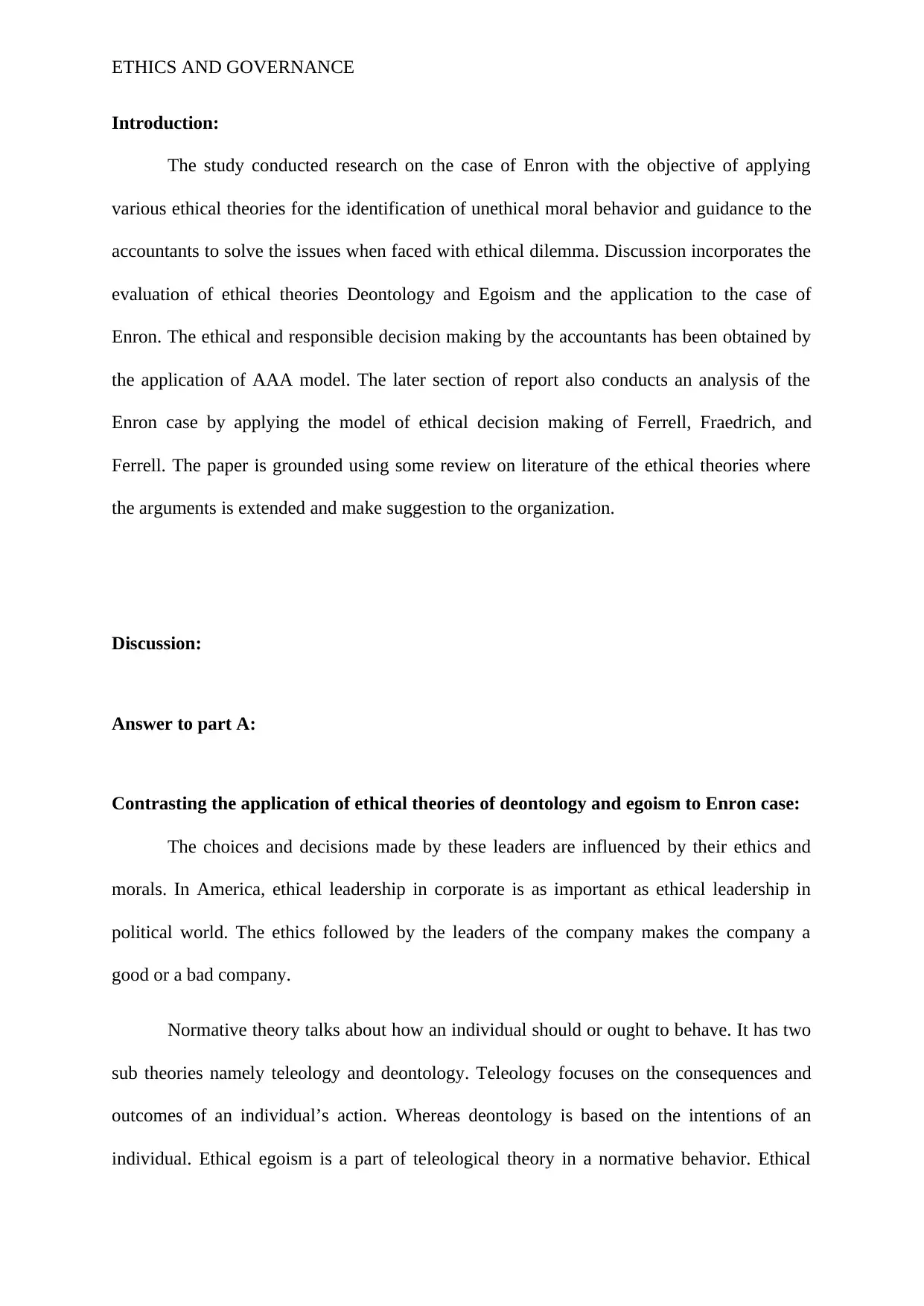
ETHICS AND GOVERNANCE
Introduction:
The study conducted research on the case of Enron with the objective of applying
various ethical theories for the identification of unethical moral behavior and guidance to the
accountants to solve the issues when faced with ethical dilemma. Discussion incorporates the
evaluation of ethical theories Deontology and Egoism and the application to the case of
Enron. The ethical and responsible decision making by the accountants has been obtained by
the application of AAA model. The later section of report also conducts an analysis of the
Enron case by applying the model of ethical decision making of Ferrell, Fraedrich, and
Ferrell. The paper is grounded using some review on literature of the ethical theories where
the arguments is extended and make suggestion to the organization.
Discussion:
Answer to part A:
Contrasting the application of ethical theories of deontology and egoism to Enron case:
The choices and decisions made by these leaders are influenced by their ethics and
morals. In America, ethical leadership in corporate is as important as ethical leadership in
political world. The ethics followed by the leaders of the company makes the company a
good or a bad company.
Normative theory talks about how an individual should or ought to behave. It has two
sub theories namely teleology and deontology. Teleology focuses on the consequences and
outcomes of an individual’s action. Whereas deontology is based on the intentions of an
individual. Ethical egoism is a part of teleological theory in a normative behavior. Ethical
Introduction:
The study conducted research on the case of Enron with the objective of applying
various ethical theories for the identification of unethical moral behavior and guidance to the
accountants to solve the issues when faced with ethical dilemma. Discussion incorporates the
evaluation of ethical theories Deontology and Egoism and the application to the case of
Enron. The ethical and responsible decision making by the accountants has been obtained by
the application of AAA model. The later section of report also conducts an analysis of the
Enron case by applying the model of ethical decision making of Ferrell, Fraedrich, and
Ferrell. The paper is grounded using some review on literature of the ethical theories where
the arguments is extended and make suggestion to the organization.
Discussion:
Answer to part A:
Contrasting the application of ethical theories of deontology and egoism to Enron case:
The choices and decisions made by these leaders are influenced by their ethics and
morals. In America, ethical leadership in corporate is as important as ethical leadership in
political world. The ethics followed by the leaders of the company makes the company a
good or a bad company.
Normative theory talks about how an individual should or ought to behave. It has two
sub theories namely teleology and deontology. Teleology focuses on the consequences and
outcomes of an individual’s action. Whereas deontology is based on the intentions of an
individual. Ethical egoism is a part of teleological theory in a normative behavior. Ethical
Paraphrase This Document
Need a fresh take? Get an instant paraphrase of this document with our AI Paraphraser
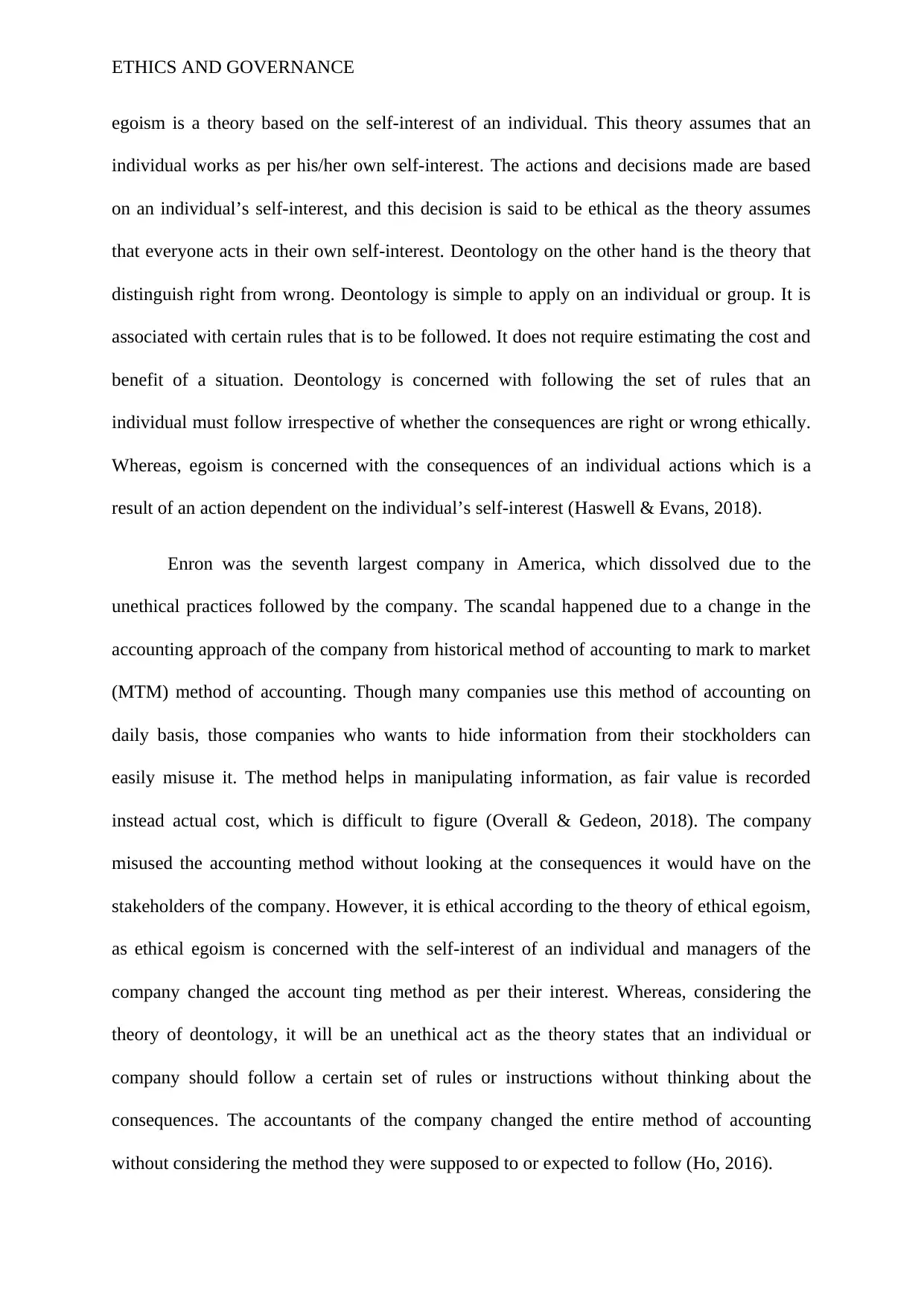
ETHICS AND GOVERNANCE
egoism is a theory based on the self-interest of an individual. This theory assumes that an
individual works as per his/her own self-interest. The actions and decisions made are based
on an individual’s self-interest, and this decision is said to be ethical as the theory assumes
that everyone acts in their own self-interest. Deontology on the other hand is the theory that
distinguish right from wrong. Deontology is simple to apply on an individual or group. It is
associated with certain rules that is to be followed. It does not require estimating the cost and
benefit of a situation. Deontology is concerned with following the set of rules that an
individual must follow irrespective of whether the consequences are right or wrong ethically.
Whereas, egoism is concerned with the consequences of an individual actions which is a
result of an action dependent on the individual’s self-interest (Haswell & Evans, 2018).
Enron was the seventh largest company in America, which dissolved due to the
unethical practices followed by the company. The scandal happened due to a change in the
accounting approach of the company from historical method of accounting to mark to market
(MTM) method of accounting. Though many companies use this method of accounting on
daily basis, those companies who wants to hide information from their stockholders can
easily misuse it. The method helps in manipulating information, as fair value is recorded
instead actual cost, which is difficult to figure (Overall & Gedeon, 2018). The company
misused the accounting method without looking at the consequences it would have on the
stakeholders of the company. However, it is ethical according to the theory of ethical egoism,
as ethical egoism is concerned with the self-interest of an individual and managers of the
company changed the account ting method as per their interest. Whereas, considering the
theory of deontology, it will be an unethical act as the theory states that an individual or
company should follow a certain set of rules or instructions without thinking about the
consequences. The accountants of the company changed the entire method of accounting
without considering the method they were supposed to or expected to follow (Ho, 2016).
egoism is a theory based on the self-interest of an individual. This theory assumes that an
individual works as per his/her own self-interest. The actions and decisions made are based
on an individual’s self-interest, and this decision is said to be ethical as the theory assumes
that everyone acts in their own self-interest. Deontology on the other hand is the theory that
distinguish right from wrong. Deontology is simple to apply on an individual or group. It is
associated with certain rules that is to be followed. It does not require estimating the cost and
benefit of a situation. Deontology is concerned with following the set of rules that an
individual must follow irrespective of whether the consequences are right or wrong ethically.
Whereas, egoism is concerned with the consequences of an individual actions which is a
result of an action dependent on the individual’s self-interest (Haswell & Evans, 2018).
Enron was the seventh largest company in America, which dissolved due to the
unethical practices followed by the company. The scandal happened due to a change in the
accounting approach of the company from historical method of accounting to mark to market
(MTM) method of accounting. Though many companies use this method of accounting on
daily basis, those companies who wants to hide information from their stockholders can
easily misuse it. The method helps in manipulating information, as fair value is recorded
instead actual cost, which is difficult to figure (Overall & Gedeon, 2018). The company
misused the accounting method without looking at the consequences it would have on the
stakeholders of the company. However, it is ethical according to the theory of ethical egoism,
as ethical egoism is concerned with the self-interest of an individual and managers of the
company changed the account ting method as per their interest. Whereas, considering the
theory of deontology, it will be an unethical act as the theory states that an individual or
company should follow a certain set of rules or instructions without thinking about the
consequences. The accountants of the company changed the entire method of accounting
without considering the method they were supposed to or expected to follow (Ho, 2016).
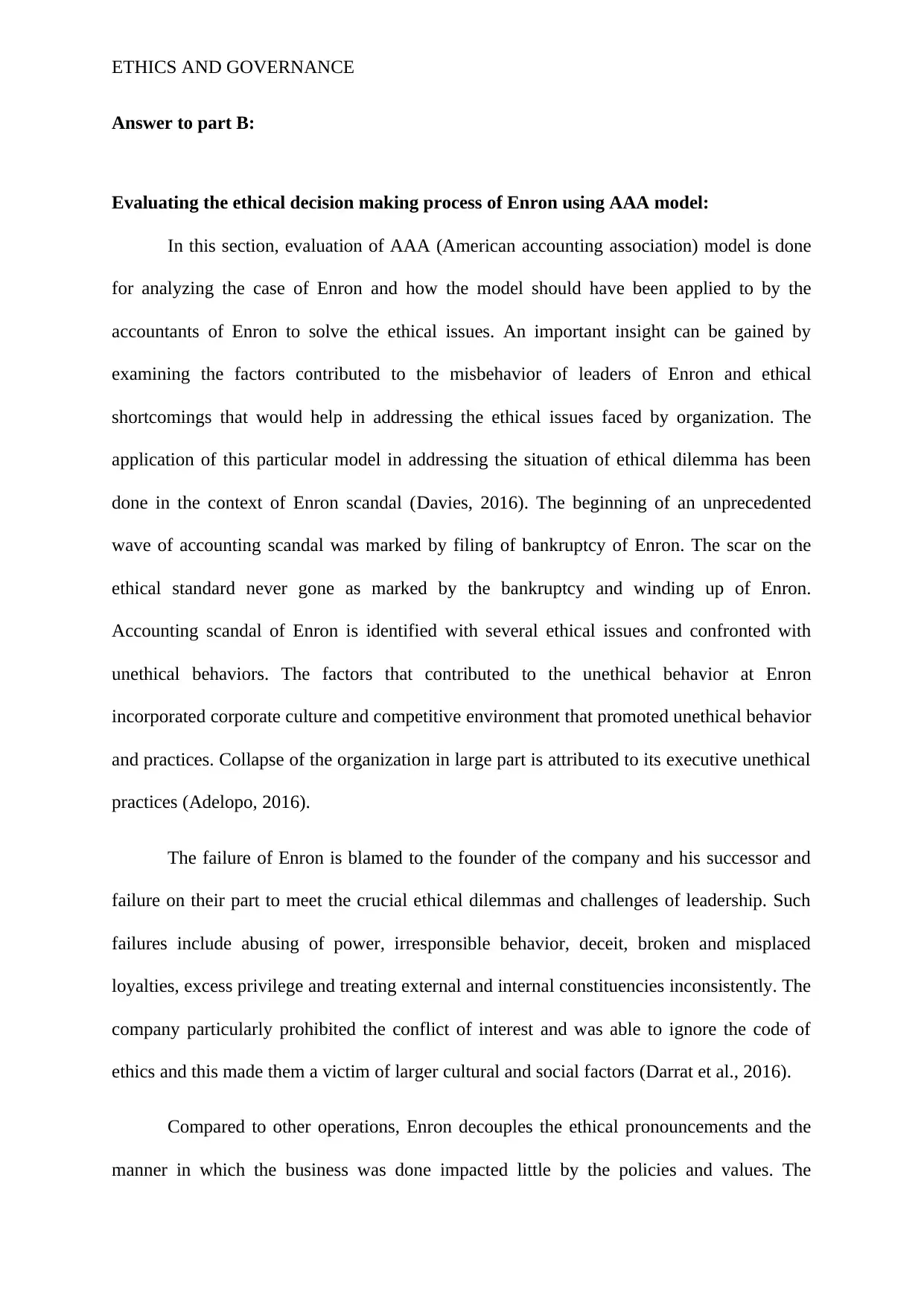
ETHICS AND GOVERNANCE
Answer to part B:
Evaluating the ethical decision making process of Enron using AAA model:
In this section, evaluation of AAA (American accounting association) model is done
for analyzing the case of Enron and how the model should have been applied to by the
accountants of Enron to solve the ethical issues. An important insight can be gained by
examining the factors contributed to the misbehavior of leaders of Enron and ethical
shortcomings that would help in addressing the ethical issues faced by organization. The
application of this particular model in addressing the situation of ethical dilemma has been
done in the context of Enron scandal (Davies, 2016). The beginning of an unprecedented
wave of accounting scandal was marked by filing of bankruptcy of Enron. The scar on the
ethical standard never gone as marked by the bankruptcy and winding up of Enron.
Accounting scandal of Enron is identified with several ethical issues and confronted with
unethical behaviors. The factors that contributed to the unethical behavior at Enron
incorporated corporate culture and competitive environment that promoted unethical behavior
and practices. Collapse of the organization in large part is attributed to its executive unethical
practices (Adelopo, 2016).
The failure of Enron is blamed to the founder of the company and his successor and
failure on their part to meet the crucial ethical dilemmas and challenges of leadership. Such
failures include abusing of power, irresponsible behavior, deceit, broken and misplaced
loyalties, excess privilege and treating external and internal constituencies inconsistently. The
company particularly prohibited the conflict of interest and was able to ignore the code of
ethics and this made them a victim of larger cultural and social factors (Darrat et al., 2016).
Compared to other operations, Enron decouples the ethical pronouncements and the
manner in which the business was done impacted little by the policies and values. The
Answer to part B:
Evaluating the ethical decision making process of Enron using AAA model:
In this section, evaluation of AAA (American accounting association) model is done
for analyzing the case of Enron and how the model should have been applied to by the
accountants of Enron to solve the ethical issues. An important insight can be gained by
examining the factors contributed to the misbehavior of leaders of Enron and ethical
shortcomings that would help in addressing the ethical issues faced by organization. The
application of this particular model in addressing the situation of ethical dilemma has been
done in the context of Enron scandal (Davies, 2016). The beginning of an unprecedented
wave of accounting scandal was marked by filing of bankruptcy of Enron. The scar on the
ethical standard never gone as marked by the bankruptcy and winding up of Enron.
Accounting scandal of Enron is identified with several ethical issues and confronted with
unethical behaviors. The factors that contributed to the unethical behavior at Enron
incorporated corporate culture and competitive environment that promoted unethical behavior
and practices. Collapse of the organization in large part is attributed to its executive unethical
practices (Adelopo, 2016).
The failure of Enron is blamed to the founder of the company and his successor and
failure on their part to meet the crucial ethical dilemmas and challenges of leadership. Such
failures include abusing of power, irresponsible behavior, deceit, broken and misplaced
loyalties, excess privilege and treating external and internal constituencies inconsistently. The
company particularly prohibited the conflict of interest and was able to ignore the code of
ethics and this made them a victim of larger cultural and social factors (Darrat et al., 2016).
Compared to other operations, Enron decouples the ethical pronouncements and the
manner in which the business was done impacted little by the policies and values. The
⊘ This is a preview!⊘
Do you want full access?
Subscribe today to unlock all pages.

Trusted by 1+ million students worldwide
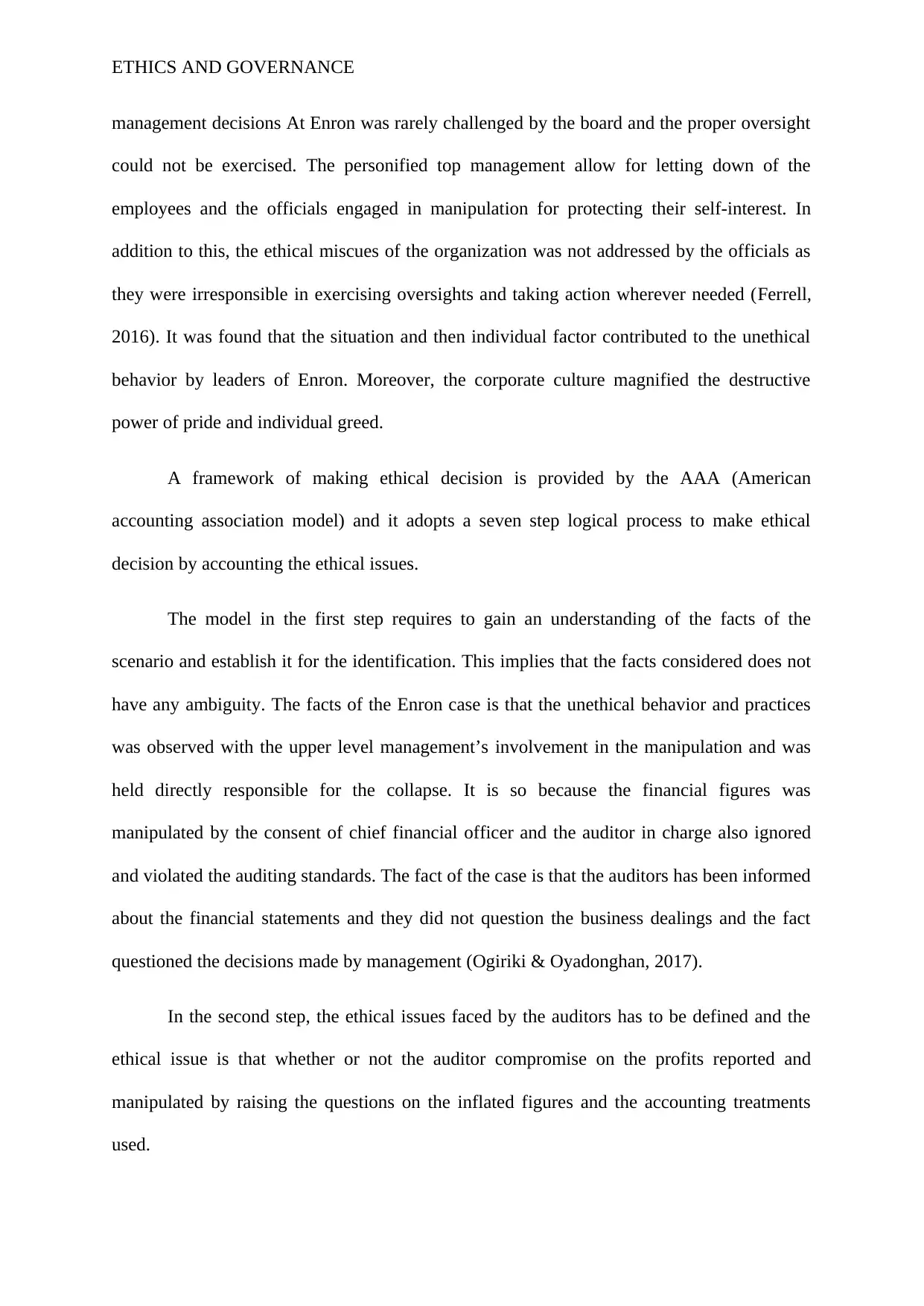
ETHICS AND GOVERNANCE
management decisions At Enron was rarely challenged by the board and the proper oversight
could not be exercised. The personified top management allow for letting down of the
employees and the officials engaged in manipulation for protecting their self-interest. In
addition to this, the ethical miscues of the organization was not addressed by the officials as
they were irresponsible in exercising oversights and taking action wherever needed (Ferrell,
2016). It was found that the situation and then individual factor contributed to the unethical
behavior by leaders of Enron. Moreover, the corporate culture magnified the destructive
power of pride and individual greed.
A framework of making ethical decision is provided by the AAA (American
accounting association model) and it adopts a seven step logical process to make ethical
decision by accounting the ethical issues.
The model in the first step requires to gain an understanding of the facts of the
scenario and establish it for the identification. This implies that the facts considered does not
have any ambiguity. The facts of the Enron case is that the unethical behavior and practices
was observed with the upper level management’s involvement in the manipulation and was
held directly responsible for the collapse. It is so because the financial figures was
manipulated by the consent of chief financial officer and the auditor in charge also ignored
and violated the auditing standards. The fact of the case is that the auditors has been informed
about the financial statements and they did not question the business dealings and the fact
questioned the decisions made by management (Ogiriki & Oyadonghan, 2017).
In the second step, the ethical issues faced by the auditors has to be defined and the
ethical issue is that whether or not the auditor compromise on the profits reported and
manipulated by raising the questions on the inflated figures and the accounting treatments
used.
management decisions At Enron was rarely challenged by the board and the proper oversight
could not be exercised. The personified top management allow for letting down of the
employees and the officials engaged in manipulation for protecting their self-interest. In
addition to this, the ethical miscues of the organization was not addressed by the officials as
they were irresponsible in exercising oversights and taking action wherever needed (Ferrell,
2016). It was found that the situation and then individual factor contributed to the unethical
behavior by leaders of Enron. Moreover, the corporate culture magnified the destructive
power of pride and individual greed.
A framework of making ethical decision is provided by the AAA (American
accounting association model) and it adopts a seven step logical process to make ethical
decision by accounting the ethical issues.
The model in the first step requires to gain an understanding of the facts of the
scenario and establish it for the identification. This implies that the facts considered does not
have any ambiguity. The facts of the Enron case is that the unethical behavior and practices
was observed with the upper level management’s involvement in the manipulation and was
held directly responsible for the collapse. It is so because the financial figures was
manipulated by the consent of chief financial officer and the auditor in charge also ignored
and violated the auditing standards. The fact of the case is that the auditors has been informed
about the financial statements and they did not question the business dealings and the fact
questioned the decisions made by management (Ogiriki & Oyadonghan, 2017).
In the second step, the ethical issues faced by the auditors has to be defined and the
ethical issue is that whether or not the auditor compromise on the profits reported and
manipulated by raising the questions on the inflated figures and the accounting treatments
used.
Paraphrase This Document
Need a fresh take? Get an instant paraphrase of this document with our AI Paraphraser
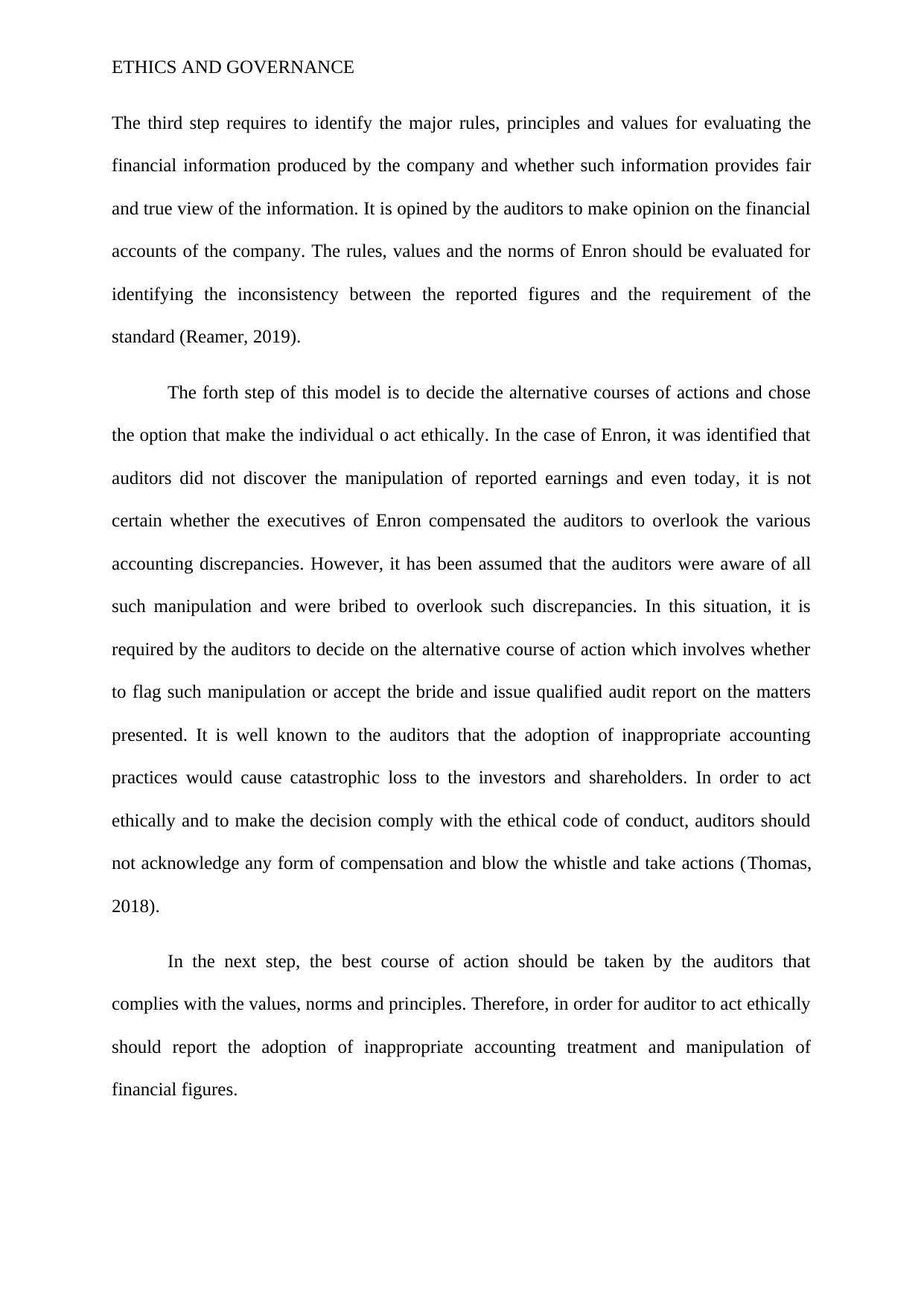
ETHICS AND GOVERNANCE
The third step requires to identify the major rules, principles and values for evaluating the
financial information produced by the company and whether such information provides fair
and true view of the information. It is opined by the auditors to make opinion on the financial
accounts of the company. The rules, values and the norms of Enron should be evaluated for
identifying the inconsistency between the reported figures and the requirement of the
standard (Reamer, 2019).
The forth step of this model is to decide the alternative courses of actions and chose
the option that make the individual o act ethically. In the case of Enron, it was identified that
auditors did not discover the manipulation of reported earnings and even today, it is not
certain whether the executives of Enron compensated the auditors to overlook the various
accounting discrepancies. However, it has been assumed that the auditors were aware of all
such manipulation and were bribed to overlook such discrepancies. In this situation, it is
required by the auditors to decide on the alternative course of action which involves whether
to flag such manipulation or accept the bride and issue qualified audit report on the matters
presented. It is well known to the auditors that the adoption of inappropriate accounting
practices would cause catastrophic loss to the investors and shareholders. In order to act
ethically and to make the decision comply with the ethical code of conduct, auditors should
not acknowledge any form of compensation and blow the whistle and take actions (Thomas,
2018).
In the next step, the best course of action should be taken by the auditors that
complies with the values, norms and principles. Therefore, in order for auditor to act ethically
should report the adoption of inappropriate accounting treatment and manipulation of
financial figures.
The third step requires to identify the major rules, principles and values for evaluating the
financial information produced by the company and whether such information provides fair
and true view of the information. It is opined by the auditors to make opinion on the financial
accounts of the company. The rules, values and the norms of Enron should be evaluated for
identifying the inconsistency between the reported figures and the requirement of the
standard (Reamer, 2019).
The forth step of this model is to decide the alternative courses of actions and chose
the option that make the individual o act ethically. In the case of Enron, it was identified that
auditors did not discover the manipulation of reported earnings and even today, it is not
certain whether the executives of Enron compensated the auditors to overlook the various
accounting discrepancies. However, it has been assumed that the auditors were aware of all
such manipulation and were bribed to overlook such discrepancies. In this situation, it is
required by the auditors to decide on the alternative course of action which involves whether
to flag such manipulation or accept the bride and issue qualified audit report on the matters
presented. It is well known to the auditors that the adoption of inappropriate accounting
practices would cause catastrophic loss to the investors and shareholders. In order to act
ethically and to make the decision comply with the ethical code of conduct, auditors should
not acknowledge any form of compensation and blow the whistle and take actions (Thomas,
2018).
In the next step, the best course of action should be taken by the auditors that
complies with the values, norms and principles. Therefore, in order for auditor to act ethically
should report the adoption of inappropriate accounting treatment and manipulation of
financial figures.
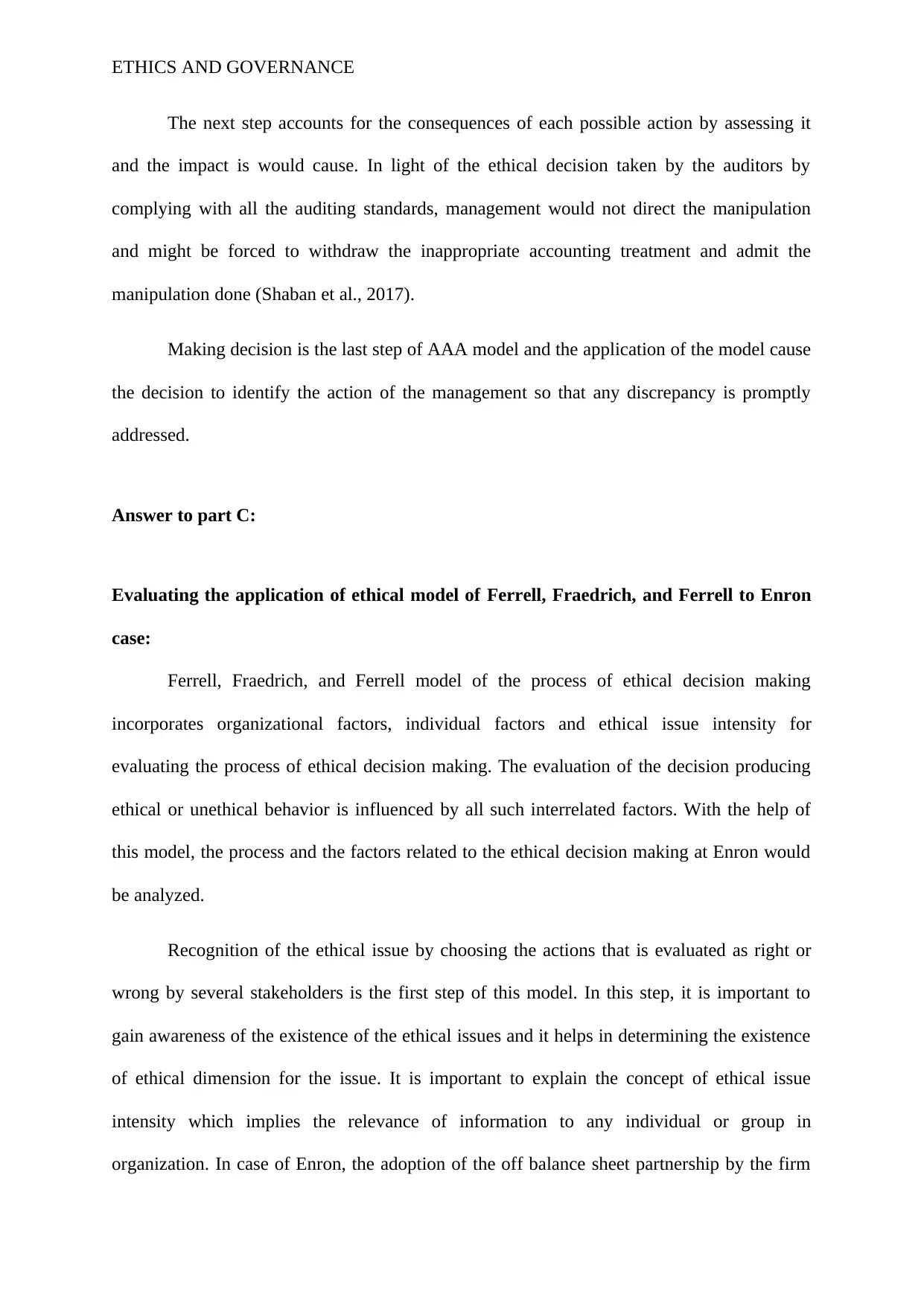
ETHICS AND GOVERNANCE
The next step accounts for the consequences of each possible action by assessing it
and the impact is would cause. In light of the ethical decision taken by the auditors by
complying with all the auditing standards, management would not direct the manipulation
and might be forced to withdraw the inappropriate accounting treatment and admit the
manipulation done (Shaban et al., 2017).
Making decision is the last step of AAA model and the application of the model cause
the decision to identify the action of the management so that any discrepancy is promptly
addressed.
Answer to part C:
Evaluating the application of ethical model of Ferrell, Fraedrich, and Ferrell to Enron
case:
Ferrell, Fraedrich, and Ferrell model of the process of ethical decision making
incorporates organizational factors, individual factors and ethical issue intensity for
evaluating the process of ethical decision making. The evaluation of the decision producing
ethical or unethical behavior is influenced by all such interrelated factors. With the help of
this model, the process and the factors related to the ethical decision making at Enron would
be analyzed.
Recognition of the ethical issue by choosing the actions that is evaluated as right or
wrong by several stakeholders is the first step of this model. In this step, it is important to
gain awareness of the existence of the ethical issues and it helps in determining the existence
of ethical dimension for the issue. It is important to explain the concept of ethical issue
intensity which implies the relevance of information to any individual or group in
organization. In case of Enron, the adoption of the off balance sheet partnership by the firm
The next step accounts for the consequences of each possible action by assessing it
and the impact is would cause. In light of the ethical decision taken by the auditors by
complying with all the auditing standards, management would not direct the manipulation
and might be forced to withdraw the inappropriate accounting treatment and admit the
manipulation done (Shaban et al., 2017).
Making decision is the last step of AAA model and the application of the model cause
the decision to identify the action of the management so that any discrepancy is promptly
addressed.
Answer to part C:
Evaluating the application of ethical model of Ferrell, Fraedrich, and Ferrell to Enron
case:
Ferrell, Fraedrich, and Ferrell model of the process of ethical decision making
incorporates organizational factors, individual factors and ethical issue intensity for
evaluating the process of ethical decision making. The evaluation of the decision producing
ethical or unethical behavior is influenced by all such interrelated factors. With the help of
this model, the process and the factors related to the ethical decision making at Enron would
be analyzed.
Recognition of the ethical issue by choosing the actions that is evaluated as right or
wrong by several stakeholders is the first step of this model. In this step, it is important to
gain awareness of the existence of the ethical issues and it helps in determining the existence
of ethical dimension for the issue. It is important to explain the concept of ethical issue
intensity which implies the relevance of information to any individual or group in
organization. In case of Enron, the adoption of the off balance sheet partnership by the firm
⊘ This is a preview!⊘
Do you want full access?
Subscribe today to unlock all pages.

Trusted by 1+ million students worldwide
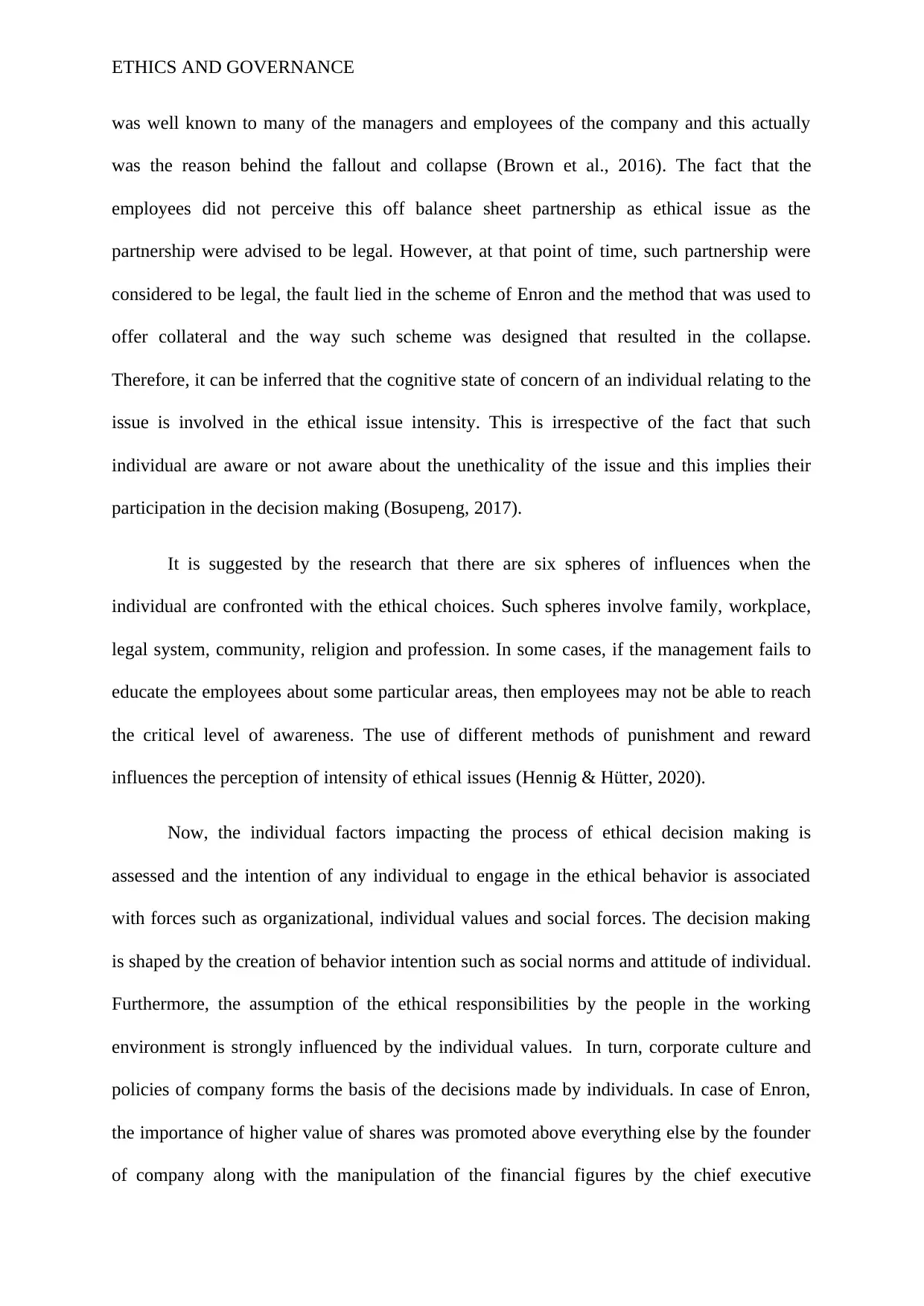
ETHICS AND GOVERNANCE
was well known to many of the managers and employees of the company and this actually
was the reason behind the fallout and collapse (Brown et al., 2016). The fact that the
employees did not perceive this off balance sheet partnership as ethical issue as the
partnership were advised to be legal. However, at that point of time, such partnership were
considered to be legal, the fault lied in the scheme of Enron and the method that was used to
offer collateral and the way such scheme was designed that resulted in the collapse.
Therefore, it can be inferred that the cognitive state of concern of an individual relating to the
issue is involved in the ethical issue intensity. This is irrespective of the fact that such
individual are aware or not aware about the unethicality of the issue and this implies their
participation in the decision making (Bosupeng, 2017).
It is suggested by the research that there are six spheres of influences when the
individual are confronted with the ethical choices. Such spheres involve family, workplace,
legal system, community, religion and profession. In some cases, if the management fails to
educate the employees about some particular areas, then employees may not be able to reach
the critical level of awareness. The use of different methods of punishment and reward
influences the perception of intensity of ethical issues (Hennig & Hütter, 2020).
Now, the individual factors impacting the process of ethical decision making is
assessed and the intention of any individual to engage in the ethical behavior is associated
with forces such as organizational, individual values and social forces. The decision making
is shaped by the creation of behavior intention such as social norms and attitude of individual.
Furthermore, the assumption of the ethical responsibilities by the people in the working
environment is strongly influenced by the individual values. In turn, corporate culture and
policies of company forms the basis of the decisions made by individuals. In case of Enron,
the importance of higher value of shares was promoted above everything else by the founder
of company along with the manipulation of the financial figures by the chief executive
was well known to many of the managers and employees of the company and this actually
was the reason behind the fallout and collapse (Brown et al., 2016). The fact that the
employees did not perceive this off balance sheet partnership as ethical issue as the
partnership were advised to be legal. However, at that point of time, such partnership were
considered to be legal, the fault lied in the scheme of Enron and the method that was used to
offer collateral and the way such scheme was designed that resulted in the collapse.
Therefore, it can be inferred that the cognitive state of concern of an individual relating to the
issue is involved in the ethical issue intensity. This is irrespective of the fact that such
individual are aware or not aware about the unethicality of the issue and this implies their
participation in the decision making (Bosupeng, 2017).
It is suggested by the research that there are six spheres of influences when the
individual are confronted with the ethical choices. Such spheres involve family, workplace,
legal system, community, religion and profession. In some cases, if the management fails to
educate the employees about some particular areas, then employees may not be able to reach
the critical level of awareness. The use of different methods of punishment and reward
influences the perception of intensity of ethical issues (Hennig & Hütter, 2020).
Now, the individual factors impacting the process of ethical decision making is
assessed and the intention of any individual to engage in the ethical behavior is associated
with forces such as organizational, individual values and social forces. The decision making
is shaped by the creation of behavior intention such as social norms and attitude of individual.
Furthermore, the assumption of the ethical responsibilities by the people in the working
environment is strongly influenced by the individual values. In turn, corporate culture and
policies of company forms the basis of the decisions made by individuals. In case of Enron,
the importance of higher value of shares was promoted above everything else by the founder
of company along with the manipulation of the financial figures by the chief executive
Paraphrase This Document
Need a fresh take? Get an instant paraphrase of this document with our AI Paraphraser
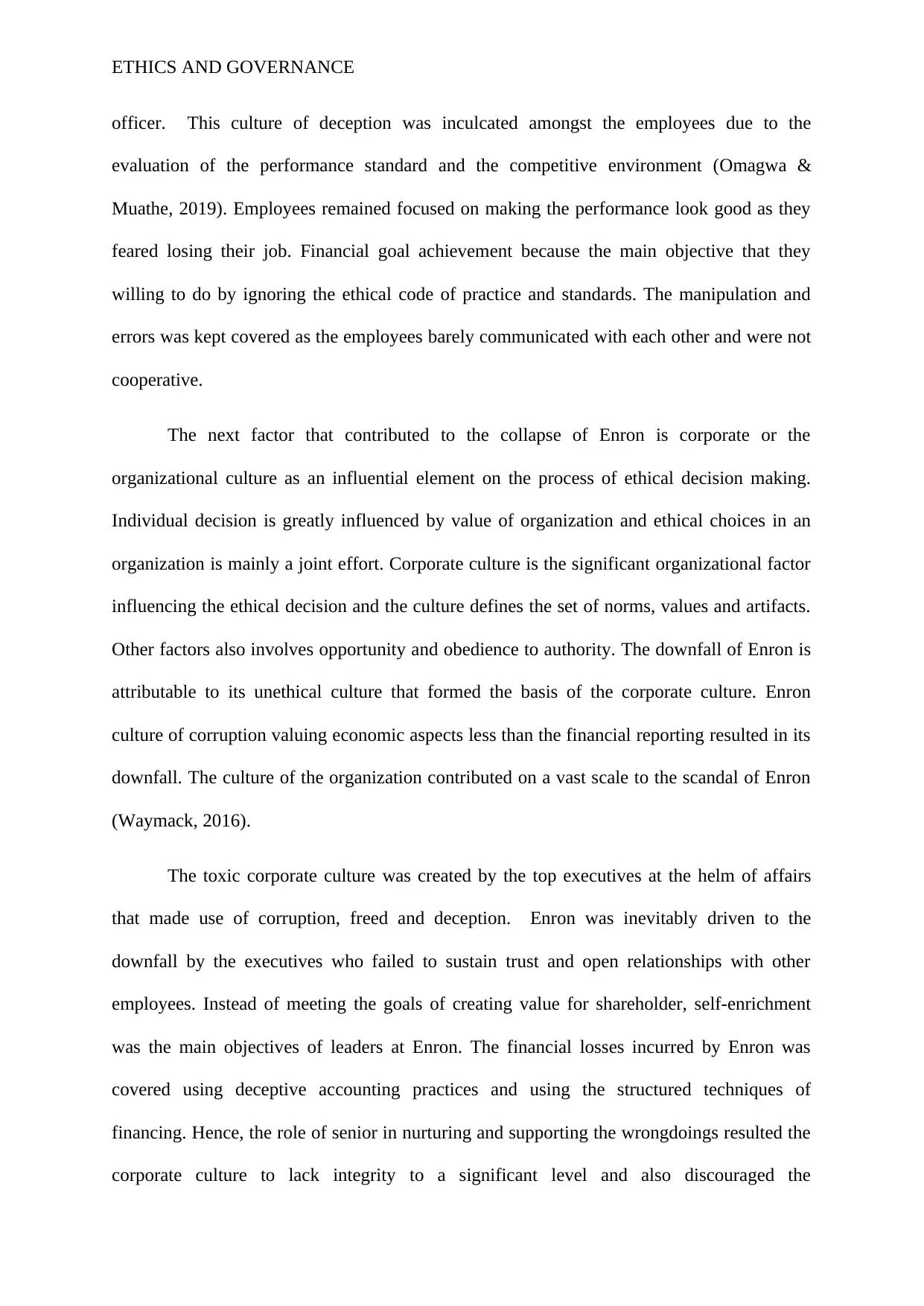
ETHICS AND GOVERNANCE
officer. This culture of deception was inculcated amongst the employees due to the
evaluation of the performance standard and the competitive environment (Omagwa &
Muathe, 2019). Employees remained focused on making the performance look good as they
feared losing their job. Financial goal achievement because the main objective that they
willing to do by ignoring the ethical code of practice and standards. The manipulation and
errors was kept covered as the employees barely communicated with each other and were not
cooperative.
The next factor that contributed to the collapse of Enron is corporate or the
organizational culture as an influential element on the process of ethical decision making.
Individual decision is greatly influenced by value of organization and ethical choices in an
organization is mainly a joint effort. Corporate culture is the significant organizational factor
influencing the ethical decision and the culture defines the set of norms, values and artifacts.
Other factors also involves opportunity and obedience to authority. The downfall of Enron is
attributable to its unethical culture that formed the basis of the corporate culture. Enron
culture of corruption valuing economic aspects less than the financial reporting resulted in its
downfall. The culture of the organization contributed on a vast scale to the scandal of Enron
(Waymack, 2016).
The toxic corporate culture was created by the top executives at the helm of affairs
that made use of corruption, freed and deception. Enron was inevitably driven to the
downfall by the executives who failed to sustain trust and open relationships with other
employees. Instead of meeting the goals of creating value for shareholder, self-enrichment
was the main objectives of leaders at Enron. The financial losses incurred by Enron was
covered using deceptive accounting practices and using the structured techniques of
financing. Hence, the role of senior in nurturing and supporting the wrongdoings resulted the
corporate culture to lack integrity to a significant level and also discouraged the
officer. This culture of deception was inculcated amongst the employees due to the
evaluation of the performance standard and the competitive environment (Omagwa &
Muathe, 2019). Employees remained focused on making the performance look good as they
feared losing their job. Financial goal achievement because the main objective that they
willing to do by ignoring the ethical code of practice and standards. The manipulation and
errors was kept covered as the employees barely communicated with each other and were not
cooperative.
The next factor that contributed to the collapse of Enron is corporate or the
organizational culture as an influential element on the process of ethical decision making.
Individual decision is greatly influenced by value of organization and ethical choices in an
organization is mainly a joint effort. Corporate culture is the significant organizational factor
influencing the ethical decision and the culture defines the set of norms, values and artifacts.
Other factors also involves opportunity and obedience to authority. The downfall of Enron is
attributable to its unethical culture that formed the basis of the corporate culture. Enron
culture of corruption valuing economic aspects less than the financial reporting resulted in its
downfall. The culture of the organization contributed on a vast scale to the scandal of Enron
(Waymack, 2016).
The toxic corporate culture was created by the top executives at the helm of affairs
that made use of corruption, freed and deception. Enron was inevitably driven to the
downfall by the executives who failed to sustain trust and open relationships with other
employees. Instead of meeting the goals of creating value for shareholder, self-enrichment
was the main objectives of leaders at Enron. The financial losses incurred by Enron was
covered using deceptive accounting practices and using the structured techniques of
financing. Hence, the role of senior in nurturing and supporting the wrongdoings resulted the
corporate culture to lack integrity to a significant level and also discouraged the
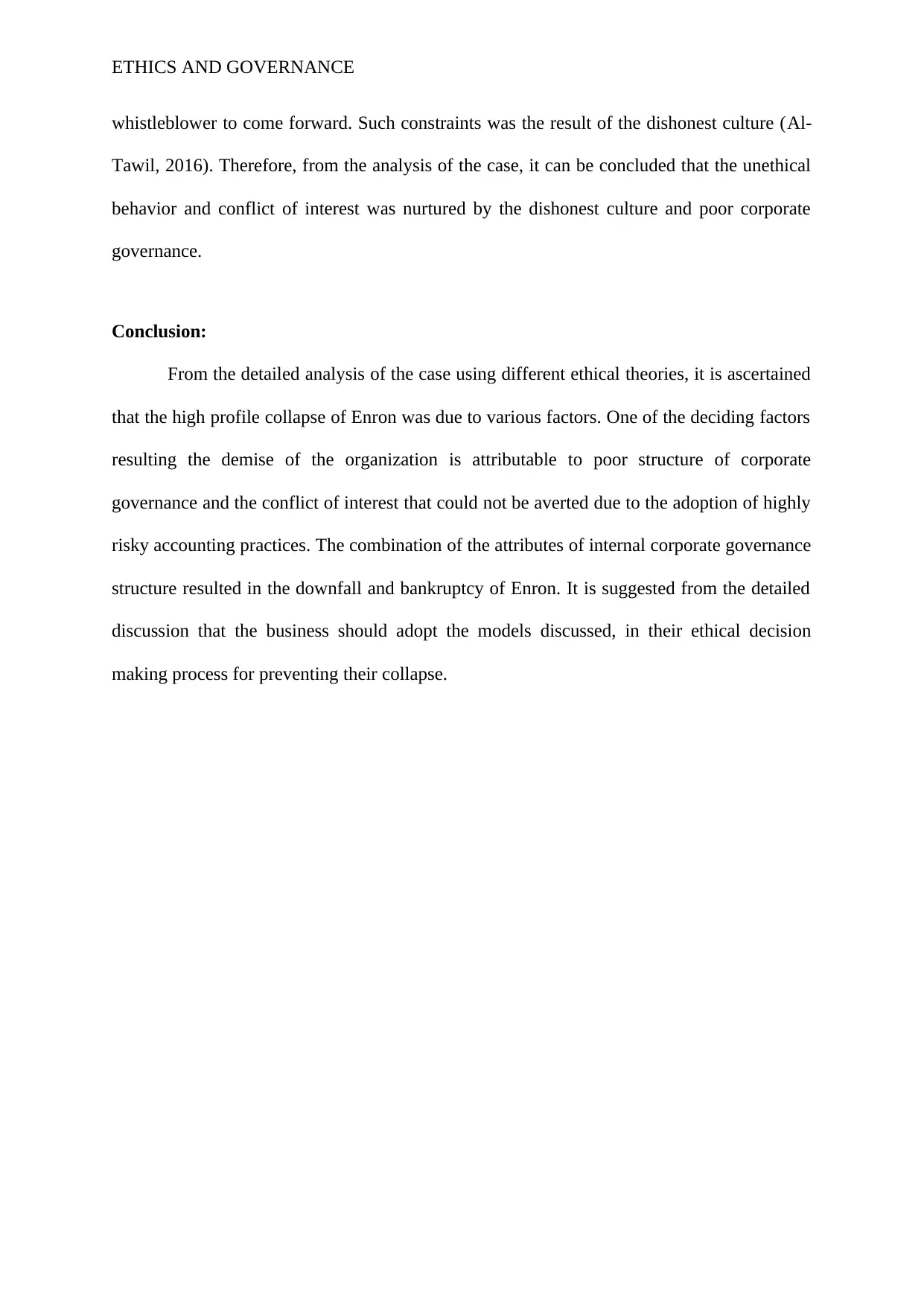
ETHICS AND GOVERNANCE
whistleblower to come forward. Such constraints was the result of the dishonest culture (Al-
Tawil, 2016). Therefore, from the analysis of the case, it can be concluded that the unethical
behavior and conflict of interest was nurtured by the dishonest culture and poor corporate
governance.
Conclusion:
From the detailed analysis of the case using different ethical theories, it is ascertained
that the high profile collapse of Enron was due to various factors. One of the deciding factors
resulting the demise of the organization is attributable to poor structure of corporate
governance and the conflict of interest that could not be averted due to the adoption of highly
risky accounting practices. The combination of the attributes of internal corporate governance
structure resulted in the downfall and bankruptcy of Enron. It is suggested from the detailed
discussion that the business should adopt the models discussed, in their ethical decision
making process for preventing their collapse.
whistleblower to come forward. Such constraints was the result of the dishonest culture (Al-
Tawil, 2016). Therefore, from the analysis of the case, it can be concluded that the unethical
behavior and conflict of interest was nurtured by the dishonest culture and poor corporate
governance.
Conclusion:
From the detailed analysis of the case using different ethical theories, it is ascertained
that the high profile collapse of Enron was due to various factors. One of the deciding factors
resulting the demise of the organization is attributable to poor structure of corporate
governance and the conflict of interest that could not be averted due to the adoption of highly
risky accounting practices. The combination of the attributes of internal corporate governance
structure resulted in the downfall and bankruptcy of Enron. It is suggested from the detailed
discussion that the business should adopt the models discussed, in their ethical decision
making process for preventing their collapse.
⊘ This is a preview!⊘
Do you want full access?
Subscribe today to unlock all pages.

Trusted by 1+ million students worldwide
1 out of 16
Related Documents
Your All-in-One AI-Powered Toolkit for Academic Success.
+13062052269
info@desklib.com
Available 24*7 on WhatsApp / Email
![[object Object]](/_next/static/media/star-bottom.7253800d.svg)
Unlock your academic potential
Copyright © 2020–2025 A2Z Services. All Rights Reserved. Developed and managed by ZUCOL.





